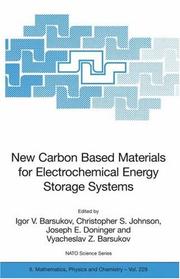| Listing 1 - 2 of 2 |
Sort by
|

ISBN: 9780387311227 0387310533 9780387310534 1441940502 9786612823312 1282823310 038731122X Year: 2006 Publisher: New York, NY : Springer US : Imprint: Springer,
Abstract | Keywords | Export | Availability | Bookmark
 Loading...
Loading...Choose an application
- Reference Manager
- EndNote
- RefWorks (Direct export to RefWorks)
In an attempt to improve, or replace, existing food processing methods, several novel technologies have been investigated. Some of these emerging technologies have become alternative means of developing new foods or improving the safety and quality of existing ones while reducing energy consumption for the food industry. Among all emerging nonthermal technologies, high intensity pulsed electric fields (PEF) is one of the most appealing due to its short treatment times and reduced heating effects. Its capability to enhance extraction processes and to inactivate microorganisms at temperatures that do not cause any deleterious effect on flavor, color or nutrient value of foods, opens interesting possibilities for the food processing industry. This book presents the information accumulated on PEF during the last 15 years by experienced microbiologists, biochemists, food technologists, and electrical and food engineers. It offers to anyone interested in this subject a comprehensive knowledge in this field. About the Editors: Javier Raso is a Professor of Food Technology at the University of Zaragoza in Spain. Volker Heinz is a Head of the German Institute of Food Technology at Quakenbrueck. .
Chemistry. --- Food Science. --- Food science. --- Chimie --- Electric fields -- Industrial applications. --- Food -- Preservation. --- Food --- Electric fields --- Radiation preservation of food --- Pulsed power systems --- Biomedical Engineering --- Chemical Engineering --- Chemical & Materials Engineering --- Health & Biological Sciences --- Engineering & Applied Sciences --- Preservation --- Industrial applications --- Preservation. --- Industrial applications. --- Food preservation --- Biotechnology. --- Field theory (Physics) --- Electromagnetic fields --- Food preservatives --- Science --- Food—Biotechnology. --- Food technology --- Chemical engineering


ISBN: 9781402048128 1402048106 9781402048104 1402048114 9786610625321 1280625325 1402048122 Year: 2006 Volume: 229 Publisher: Dordrecht : Springer Netherlands : Imprint: Springer,
Abstract | Keywords | Export | Availability | Bookmark
 Loading...
Loading...Choose an application
- Reference Manager
- EndNote
- RefWorks (Direct export to RefWorks)
Carbonaceous materials play a fundamental role in electrochemical energy storage systems. Carbon in the structural form of graphite is widely used as the active material in lithium-ion batteries; it is abundant, and environmentally friendly. Carbon is also used to conduct and distribute charge effectively throughout composite electrodes of supercapacitors, batteries and fuel cells. The electronic conductive pathways are critical to delivering and extracting current out of the device. However, many challenges and the understanding of the role of carbon and its stability and efficiency in charge storage applications still exists. This NATO-ARW volume contains a diverse collection of papers addressing the role of carbon in some key electrochemical systems, both conventional and emerging. These papers discuss the latest issues associated with development, synthesis, characterization and use of new advanced carbonaceous materials for electrochemical energy storage. Such systems include: metal-air primary and rechargeable batteries, fuel cells, supercapacitors, cathodes and anodes of lithium-ion and lithium polymer rechargeable batteries, as well as nanocarbon materials of the future.
halfgeleiders --- Electronics and optics of solids --- engineering --- brandstofcellen --- nanotechniek --- Electrochemistry --- fysicochemie --- Electrical engineering --- elektrochemie --- transistoren --- elektrische energie --- fysica --- Solid state physics --- Ceramic materials --- Electronics --- Batteries (Ordnance) --- Fuel cells --- Matériaux céramiques --- Electroniques matériaux --- Batteries (Science militaire) --- Piles à combustible --- Congresses --- Materials --- Congrès --- EPUB-LIV-FT LIVCHIMI SPRINGER-B --- Materials. --- Chemistry. --- Optical materials. --- Optics, Lasers, Photonics, Optical Devices. --- Energy Storage. --- Materials Science, general. --- Electrochemistry. --- Energy Systems. --- Optical and Electronic Materials. --- Optics --- Physical sciences --- Engineering --- Engineering materials --- Industrial materials --- Engineering design --- Manufacturing processes --- Congresses. --- Lasers. --- Photonics. --- Energy storage. --- Materials science. --- Energy systems. --- Electronic materials. --- Electronic materials --- Chemistry, Physical and theoretical --- Material science --- Storage of energy --- Force and energy --- Power (Mechanics) --- Flywheels --- Pulsed power systems --- New optics --- Light amplification by stimulated emission of radiation --- Masers, Optical --- Optical masers --- Light amplifiers --- Light sources --- Optoelectronic devices --- Nonlinear optics --- Optical parametric oscillators
| Listing 1 - 2 of 2 |
Sort by
|

 Search
Search Feedback
Feedback About
About Help
Help News
News